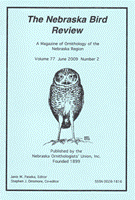Nebraska Ornithologists' Union

Nebraska Bird Review
Date of this Version
9-2004
Document Type
Article
Citation
Nebraska Bird Review (September 2004) 72(3).
Abstract
The coverage of the state by observers who report their sightings, mostly to the listserv NEBirds, is very good relative to their rather low number. Even so, there are parts of the state that are only recently revealing their secrets. Extensive work in the Panhandle in the late 1990s, including mist-netting by Steve Dinsmore, showed that several western species are regular migrants through that part of the state, and similar extensive coverage of waterbirds and shorebirds at Lake McConaughy yielded similar valuable information, following the pioneering efforts there by Dick Rosche. This report contains many references to another interesting area only now being covered seriously, the cedar canyons of southeast Lincoln County. T.J. Walker has come up with many interesting findings of nesting and resident birds that can be read here.
Perplexing to many are the changes in Canada Goose taxonomy; simply put, as far as Nebraska is concerned, the small ones (Mallard-sized, small bills, short necks) are now "Cackling Goose", Branta hutchinsii, and virtually all of the others are "Canada Goose" B. canadensis. As is often the case with taxonomy, the devil is in the details, but we won't get into those here! There are many good discussions of the topic at various internet sites.
Most of the exciting news this summer was to do with shorebirds, including stilts, plovers, and the rest. Black-necked Stilts are expanding their numbers and breeding range significantly in western Nebraska, with several instances of breeding and high numbers reported. The dry-down of Lake McConaughy, a rather spectacular phenomenon, has provided huge expanses of seemingly perfect breeding habitat for Snowy and Piping Plovers. Very large numbers of these birds were encountered, with correspondingly large numbers of nests found. Intriguingly large counts of Marbled Godwits in June suggest nesting failure in the breeding range located essentially north of Nebraska, but some observers are wondering whether breeding occurred within the state. Little or no firm evidence was provided, however, and there are still fewer than five breeding records for the state.


Comments
Copyright 2004, Nebraska Ornithologists' Union. Used by permission.